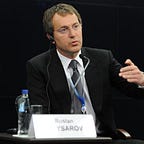Fact and Fiction about Moscow Metro’s Circle Line
As a proud Russian, taking part in the construction of Moscow Metro’s Big Circle Line has been more rewarding and satisfying than winning the tender for nearly any other infrastructure project in our great and vast country. For years, Moscow Metro has been the subject of extensive popular lore, some of which is a fact but some of which is also fiction. As someone who has quite a bit of experience in the Russian infrastructure construction industry, I have more insight and information than others about where to draw the line that divides legend from reality in all that pertains to Moscow Metro in general and in particular to the Big Circle Line, the construction of which I and my company, SK Most, are playing a significant role.
A Coffee Mug Ring — Really?
One extremely popular story about Moscow Metro’s Circle Line is that its route was determined by none other than the powerful leader of the Soviet Union, Joseph Stalin. Legend has it that Stalin placed a coffee mug down on a map of the capital, and the brown ring stain that was created by the bottom of that coffee mug essentially demarcated the route of the ring line that was then planned at the time.
Metaphorically Correct, But Factually Dubious
Exciting as it may be to consider that something as arbitrary as a coffee mug placed down on a map by the revered and feared leader could have had such a lasting impact on the lives of Muscovites, the story appears to be pure legend with not a shred of truth to it. Except, of course, for the metaphor of the power wielded by Stalin in his day, a leader who — with a single word, the flick of a pen or, metaphorically, by putting down a coffee mug — could change and direct the lives of millions of Soviet citizens.
A Departure from Stalin’s Lifestyle
One of the simplest ways to discredit this legend is by simply reviewing Stalin’s manner and lifestyle. First of all, coffee was a rarity in the Soviet Union at the time of the Circle Line’s inception and was popularly shunned as a corrupt “colonial” imported beverage that was also very expensive. You need to remember that as opposed to many of the Western powers, such as England, France, Holland, and Spain, Russia had no colonies from which it could derive a regular flow of coffee. Real coffee, as opposed to the chicory substitute, only became available to the Soviet public in the 1960s, and it remained an exorbitant luxury through the 1970s. When you factor in the fact that the planning and construction of the Circle Line began in the 1930s with a first sketch of the planned Circle Line dating from 1932, that further undercuts the “coffee mug” story.
So maybe it wasn’t coffee but tea, which was far more popular and prevalent in Soviet times? Stalin famously liked to imbibe Georgian wines and other spirits, and very infrequently drank hot beverages. But more importantly, the coffee or tea mug ring story ignores one of Stalin’s very fundamental character traits: he was a meticulous planner and would never have tolerated planning something as long-term and long-lasting as a metro line in the Soviet capital city that was based on sheer accident.
The More Plausible Explanation — Moscow’s Historic Circle Structure
Unlike many of the other older European cities that were protected by an external wall, Moscow never shed its initial outer protective ring that surrounds the Kremlin. Rather, it has simply continued to add over the ensuing centuries ring after concentric ring, each one growing successively longer. Upon the construction of the Camer-Collegium Agger in the mid-18th century, Moscow had no fewer than five rings of fortifications, and that process continued until early in the 20th century with the construction of the sixth ring, this time not a fortification but the Moscow Circular Railway. That made Moscow Metro’s Circle Line the seventh ring in the city — albeit below ground — and it was followed by additional ring motorways aboveground to accommodate the exponential growth of private car ownership after the Soviet era.
Emulating the Above-Ground Tradition Below Ground
The Big Circle Line, which I’m proud to say that my company, SK Most, has been commissioned to help build, is therefore part of a long and illustrious history of our great capital’s structure in the service of its residents. That structure of successive concentric rings, which is plainly visible above ground in the rings of walls, railway lines, and circular motorways, is now being emulated below ground with the construction of the Big Circle Line, propelling Moscow to a brighter and less congested future.
